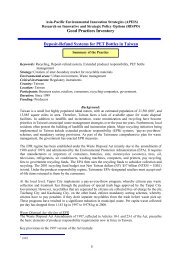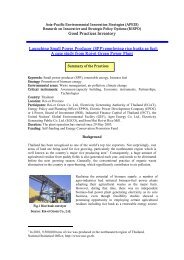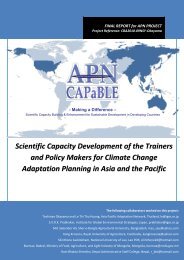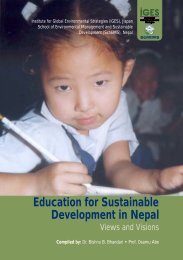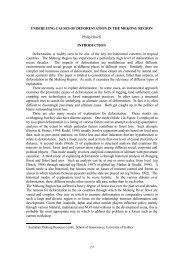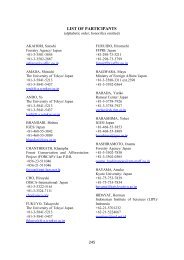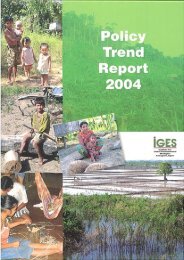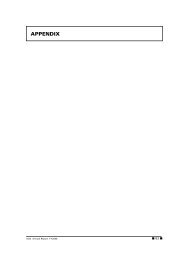final evaluation report akk_iges_final.pdf - IGES EnviroScope
final evaluation report akk_iges_final.pdf - IGES EnviroScope
final evaluation report akk_iges_final.pdf - IGES EnviroScope
Create successful ePaper yourself
Turn your PDF publications into a flip-book with our unique Google optimized e-Paper software.
APFED Project Final Evaluation Report 2011<br />
2. Annexure II: Questionnaire for measuring the impact of<br />
the Project: Communities<br />
S No: _________________________; Village Name: ___________________________; Upzila name: ___________________________<br />
1. Respondent Age:_____ Gender: �Male �Female �Primary beneficiary �Secondary<br />
2. Occupation: �Farmer, �Rural artisan, �Business, �Others<br />
(Specify:_________________________________)<br />
3. Selection of the beneficiary: Do you think the beneficiaries are fairly chosen through community<br />
consultation? �Yes �No �Not aware about the procedure followed for selection<br />
4. Do you think the project has chosen the correct interventions suitable for your location? �Yes �No �Not<br />
aware about the nature of interventions chosen<br />
5. What is the nature of your participation in the project?<br />
� Attended the meetings conducted � Received training � Received raised house � Received seeds<br />
� Received fruit trees � Member of the Climate Change Management Committee<br />
6. Rate how the project has helped you to adapt to the climate change (1 is least and 5 is most effective in<br />
adapting to climate change)? � 1 �2 �3 �4 �5<br />
7. Rank components of the project in terms of helping you adapt to the climate change (rank top 5)<br />
Item Rank<br />
1. Raised housing ________<br />
2. Livelihood Training ________<br />
3. Awareness generation ________<br />
4. CCMC formation ________<br />
5. Training on early warning ________<br />
6. Others (Specify:___________________________) ________<br />
8. The relevance of project to your local needs (as a group/society): �100% relevant, �80% �60%, �40%,<br />
�20%, �Not relevant, �Not sure<br />
9. Rate the project interventions for their usefulness on the scale of 1-5 where 1 is not useful and 5 is very<br />
useful<br />
Type of project intervention Rating for their usefulness (1 is not useful, 5 is very useful)<br />
1. Raised housing � 1 �2 �3 �4 �5<br />
2. Livelihood Training � 1 �2 �3 �4 �5<br />
3. Awareness generation � 1 �2 �3 �4 �5<br />
4. CCMC formation � 1 �2 �3 �4 �5<br />
5. Training on early warning � 1 �2 �3 �4 �5<br />
6. Others (Specify:___________________________) � 1 �2 �3 �4 �5<br />
10. Rate the project interventions for their sustainability on the scale of 1-5 where 1 is unsustainable and 5 is<br />
highly sustainable<br />
Type of project intervention Rating for their usefulness (1 is not useful, 5 is very useful)<br />
1. Raised housing � 1 �2 �3 �4 �5<br />
2. Livelihood Training � 1 �2 �3 �4 �5<br />
3. Awareness generation � 1 �2 �3 �4 �5<br />
4. CCMC formation � 1 �2 �3 �4 �5<br />
5. Training on early warning � 1 �2 �3 �4 �5<br />
6. Others (Specify:___________________________) � 1 �2 �3 �4 �5<br />
11. How do you think the project sustainability can be improved further?<br />
� By extended project funding, � By continued engagement of local communities by the NGO, � By<br />
sharing success story with communities nearby, � By sharing success story with government, � By<br />
sharing success story with elected members, � All above<br />
12. What project component has helped you the most in increasing your<br />
income?__________________________<br />
13. Why?________________________________________________________________________<br />
51



